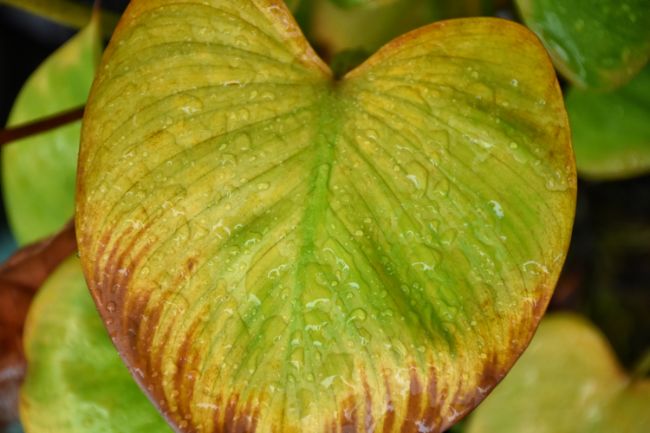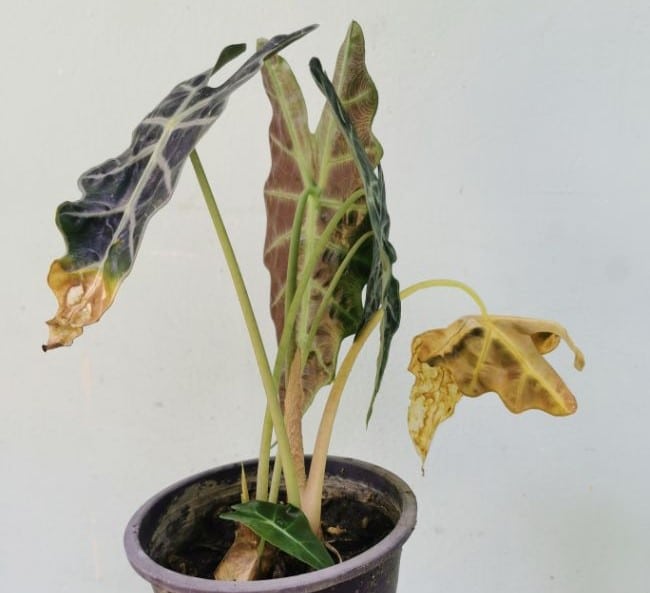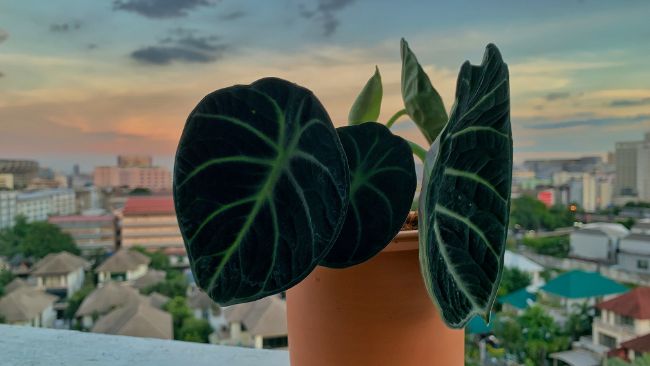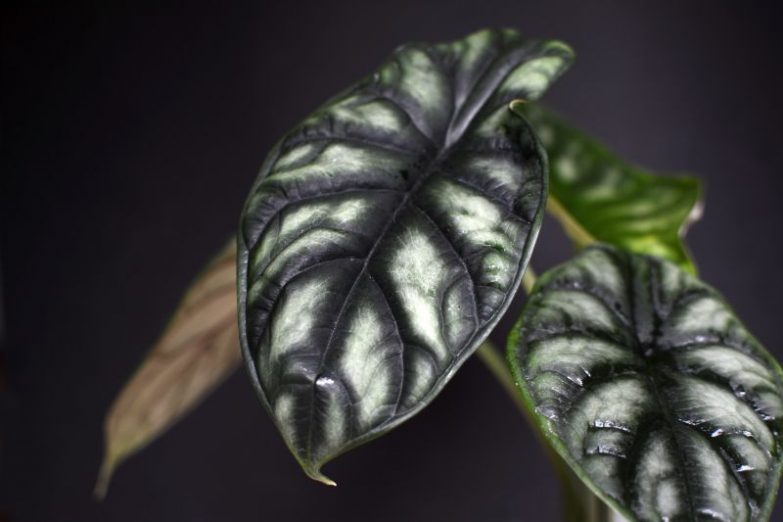With bold and beautiful leaves, that come with diverse appearances, Alocasias are a joy to keep as houseplants. The only problem is they can be a little fussy at times. Alocasia leaves drooping is a common problem, with a number of causes. Thankfully, drooping leaves can easily be fixed and prevented.
Alocasia leaves drooping is most commonly due to overwatering or underwatering. Other common reasons include lighting problems, temperature stress, pests, dormancy, and low humidity. Correcting the underlying problem will often lead to your Alocasia recovering.
Why Are My Alocasia Leaves Drooping?
I’m a big fan of Alocasias, but I have to admit that they need more care and attention than most houseplants. A drooping Alocasia should never be ignored, as it is almost always a sign of a problem. If you take the time to inspect your plant and the care you are providing, you should be able to identify the problem.
This article will discuss the common causes of Alocasia leaves drooping, providing helpful tips to correctly identify the problem and take steps to improve the situation.
Overwatering
Many people think that underwatering is the most common cause of Alocasia leaves drooping, but overwatering is in fact a much more common issue. Both problems result in the plant receiving less water than it needs, but overwatering is much more serious.
Why I say the term overwatering, what I mean is anything that causes the soil to remain soggy and waterlogged for a prolonged period of time. This results in the airspaces in the soil being filled with water. This prevents normal air circulation within the soil, which is essential for the survival of the roots.
Without a steady supply of air, the roots are unable to respire or function properly, and prolonged soggy conditions will lead to the roots dying and succumbing to opportunistic infections.
All this is bad news for your Alocasia, as the roots will not be able to absorb the water and nutrients it needs to thrive, resulting in your Alocasia drooping. Overwatering results in the roots being deprived of oxygen due to the waterlogged soil. The roots then die and the plant can’t absorb water, which will result in your Alocasia leaves drooping.
How To Identify An Alocasia Drooping Due To Overwatering
There are several symptoms of overwatering which you can identify to see if this is the cause of your Alocasia leaves drooping;
- Soggy Soil – Look for soil that remains wet for many days after watering. If the soil still feels very wet 5-7 days after watering, then your plant is at high risk of overwatering, resulting in a drooping and unhappy Alocasia.
- Generalized Leaf Yellowing – This often starts with the lower leaves first, before spreading to all of the foliage. Read more about the causes of yellow leaves on houseplants here.
- Leaf Edema – A plant that has absorbed too much water will sometimes develop watery blisters on the surface of its leaves. This is less commonly seen on Alocasias, but I have seen it a number of times on drooping Alocasias that have been overwatered.
- Wet Brown Spots – An overwatered Alocasia can often be troubled with bacterial leaf spot diseases. These often appear as wet-looking brown spots on the foliage.
- Rotting Smell – The end result of overwatering is root rot. This will be accompanied by the characteristic smell of rotting plant tissue. Have a gentle smell around the base of your plant to see if you can smell rotting roots. If so, you need to take immediate action to treat the root rot to save your plant.

Things That Increase The Risk Of Overwatering Causing Your Alocasia To Droop
There are a number of factors that will greatly affect the risk that you will end up with an overwatered plant, regardless of the frequency that you water your Alocasia.
- Poorly Draining Soil – Planting your Alocasia in soil that drains poorly. Water should soak into the soil within seconds of watering. If water sits on the surface for longer than this, you should consider repotting into a potting mix that drains better.
- Using A Pot With Few Or No Drainage Holes – Make sure your Alocasia is planted in a pot that can drain freely, to prevent the roots sitting in soggy soil.
- Overpotting – Planting an Alocasia in a pot that is too large for the plant dramatically increases the time it will take for the soil to dry out, increasing the risk of overwatering. Choose a pot that is only just big enough for your plant. When repotting, don’t increase the size of the pot by more than 1-2 inches.
- Time Of Year – Alocasias grow much more slowly, or often enter a dormant state in the winter. Their water requirements decrease dramatically during this time. I recommend “sip watering” over the winter as it often takes too long for a thoroughly watered pot to dry out when growth is slow and temperatures and light are lower.
- Lighting – Your Alocasia’s growth rate is primarily impacted by the available light. An Alocasia kept in a dark corner will grow slowly and use little water. This can result in the soil staying wet for a long time. If your Alocasia is drooping, consider moving to a brighter location to stimulate faster growth and higher water use. Read my article explaining lighting for houseplants to learn more.
How To Fix Alocasia Leaves Drooping Due To Overwatering
The main thing to do is to check your plant regularly to see if any problems are developing. If you think your Alocasia may be drooping due to overwatering, read my guide to fixing an overwatered plant. It is important to act quickly, as overwatering leading to root rot can quickly lead to the death of your plant.
Additionally, read my guides to caring for Alocasia Amazonica, Alocasia zebrina, and Alocasia Frydek, which provide specific, as well as general tips, to keep your Alocasias in great condition.
Underwatering
Alocasias are not particularly well suited to coping with too much or too little water. This is due to the remarkably consistent conditions that they experience in their natural habitat.
Thankfully, an Alocasia drooping due to underwatering is easy to identify and fix. Here are the signs to look out for;
- The soil will be dry, or you will notice that the soil dries out within just a few days of watering your plant.
- You will notice brown, crispy leaf edges or leaf tips. These are a result of a chronic lack of water reaching the extremities of the foliage. Any brown areas of foliage will feel crispy and dry, not wet.
- Your plant may show signs of being rootbound or may be planted in a very small pot.
- Some retailers sell miniature versions of Alocasia plants, potted in cute little pots. These will dry out much faster and will be at a much greater risk of drooping due to underwatering.
How To Fix An Alocasia Drooping Due to Underwatering
Look for any factors that are contributing to the underwatering. I know in my case it is usually just that I have been a little less attentive to the needs of my plant. However, sometimes it can be a sign that your Alocasia is root bound or is drying out too quickly due to excess light, heat or humidity.
How Often Should I Water My Alocasia?
I normally keep quite a close eye on my Alocasias every few days to monitor their watering needs. In general, I water my Alocasias once the soil surface or the top half-inch of soil feels dry. In winter, I let them dry out a little more. I have a few great tips in this article to help you know when to water your houseplants.
If you are having to water your Alocasia very frequently, consider whether you need to make changes to stop the plant drying out so quickly, such as repotting your plant if it is rootbound. Similarly, if it is taking two weeks for the soil surface to dry out, you should definitely make changes, to reduce the risk of overwatering.

Low Humidity
Alocasias normally grow in areas of high or very high humidity, and this can be hard to replicate in our homes. Many houseplants will tolerate the more arid conditions in our homes, but Alocasias are not one of these. They will soon show their displeasure if humidity levels are much below 40%.
Alocasia leaves drooping due to low humidity will be accompanied by other symptoms of low humidity, including leaf curling, brown leaf tips, and leaf edges. Low humidity is closely linked to underwatering, as this will cause the plant to transpire at an increased rate, increasing the risk of underwatering.
The unique issue with low humidity is that it causes localized drying of the leaves at a much faster rate than the plant as a whole. This means that the leaves can often be affected in isolation from the rest of the plant. Low humidity disproportionately affects the delicate leaf edges, particularly those that are furthest from the roots.
The plant is unable to supply water from the roots at a fast enough rate to replace that lost through the leaves, resulting in the leaf edges and tips dying and turning brown. This can lead to your Alocasia leaves drooping or curling in isolation from the rest of the plant.
I hugely recommend getting a digitial thermometer and hygrometer to monitor your Alocasias. This will tell you what the maximum, minimum and current humidity levels are. Place this next to your Alocasia to help you determine whether humidty is at an adequate level.
How To Stop Alocasia Leaves Drooping Due To Low Humidity
If humidity levels are regularly below 40%, you should take steps to increase this. Grouping your houseplants, or using a humidity tray are good options, or you could use an electric humidifier. Read my article on how to increase humidity for your houseplants if you’d like to know more.
Low Light
Lighting is the number one factor that impacts the health of your houseplants, and Alocasias are no exception. It is essential to provide bright, indirect lighting for your Alocasias for their long-term health.
Low light slows growth, reduces water requirements, and increases the risk of overwatering. If your Alocasia is placed far from a window, particularly in a north-facing room, it likely isn’t getting enough light. Don’t forget that light varies massively during the year, so a location that provides plenty of light in summer, may be woefully inadequate in winter.

Temperature Stress And Drafts
Alocasias generally do well in temperatures of 60ºF (15ºC) to 82ºF (28ºC), but they are best kept towards the middle of this temperature range. They are particularly susceptible to hot or cold drafts that cause repeated temperature stress. This will easily result in your Alocasia leaves drooping.
Check to make sure your Alocasia is not placed close to heating or cooling vents or is close to a leaky window. Moving your plant should result in the foliage perking up again if you have caught the problem early. Sometimes drooping leaves will not recover, but with good care, the plant will soon grow new, healthy leaves.
Pests
Alocasias can be quite prone to sap-sucking pests. Spider mites, mealybugs, scale, thrips and aphids can all attack, resulting in your Alocasia leaves drooping.
It is important to check your plants on a regular basis to see if there are any signs of pests. Doing this at the same time you are checking to see if your plant needs watered is a good idea. Remember to check both the top and undersides of the leaves and the petioles for any telltale signs.
You may see physical evidence of the bugs, or may see yellow spots on the leaves, and drooping in cases of a severe infestation. If you’ve found bugs but aren’t sure what it is or how to treat it, check out my guide to treating and preventing common houseplant pests.
Dormancy
Dormancy is one of the only causes of Alocasia leaves drooping that is normal and largely to be expected. Alocasias have a natural cycle that involves periods of active growth, followed by dieback and periods of dormancy.
Dormancy is often triggered by exposure to lower light and temperatures, and will normally happen at some point to most Alocasias grown indoors. Sometimes, dormancy can be partial, and other times all the foliage will droop and die, followed by the reemergence of new foliage given time.
Dormancy can be unpredictable when Alocasias are grown indoors, and if you provide steady temperatures and lighting year-round, your Alocasia may never enter a period of dormancy.
If your Alocasia appears to be entering dormancy, you should cut back on watering, letting the top few inches of soil dry out before watering. You should provide moderate light and temperatures until new growth emerges. Have patience, as dormancy can last as short as a few weeks, or more than 6 months.
Last Word
I hope you have found this article helpful. Just remember that the most likely causes of Alocasia leaves drooping are watering problems, so this should be the first thing you investigate.
All aspects of plant care are linked, so sometimes there can be a combination of problems causing the issue. Take a methodical approach to assess your plant and the care conditions and you will soon identify the problem and be able to take steps to fix your Alocasia.

